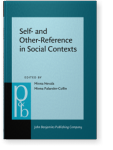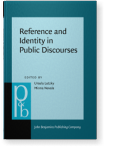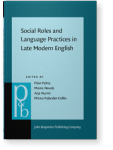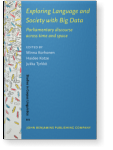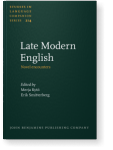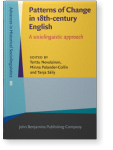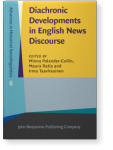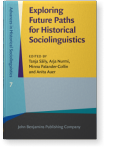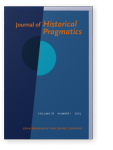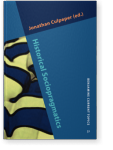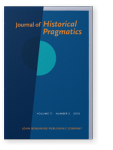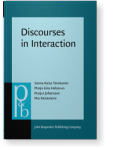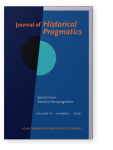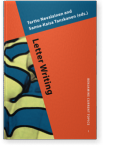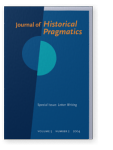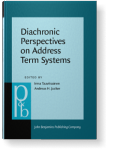Minna Nevala
List of John Benjamins publications for which Minna Nevala plays a role.
Online Resource
E-ISSN 1877-9646
Self- and Other-Reference in Social Contexts: From global to local discourses
Edited by Minna Nevala and Minna Palander-Collin
[Pragmatics & Beyond New Series, 342] 2024. v, 195 pp.
Subjects Communication Studies | Discourse studies | Pragmatics
Reference and Identity in Public Discourses
Edited by Ursula Lutzky and Minna Nevala
[Pragmatics & Beyond New Series, 306] 2019. vi, 284 pp.
Subjects Discourse studies | Pragmatics | Sociolinguistics and Dialectology
Social Roles and Language Practices in Late Modern English
Edited by Päivi Pahta, Minna Nevala, Arja Nurmi and Minna Palander-Collin
[Pragmatics & Beyond New Series, 195] 2010. viii, 241 pp.
Subjects English linguistics | Germanic linguistics | Historical linguistics | Pragmatics | Sociolinguistics and Dialectology
The Language of Daily Life in England (1400–1800)
Edited by Arja Nurmi, Minna Nevala and Minna Palander-Collin
[Pragmatics & Beyond New Series, 183] 2009. vii, 312 pp.
Subjects English linguistics | Germanic linguistics | Historical linguistics | Pragmatics | Sociolinguistics and Dialectology
2024 Chapter 6. Intragroup marginalization in social media: Self- and other-reference on a plus-size fashion brand’s Instagram page Self- and Other-Reference in Social Contexts: From global to local discourses, Nevala, Minna and Minna Palander-Collin (eds.), pp. 114–137 | Chapter
This chapter discusses plus-size group membership in Instagram (IG) posts published by the fashion retailer Fashion Nova Curve. Moreover, we focus on the ways in which self- and other-reference are used as tools for Intragroup Marginalization (IM). By IM we mean distancing by group members that… read more
2024 Chapter 1. Self- and other-reference in social contexts: From global to local discourses Self- and Other-Reference in Social Contexts: From global to local discourses, Nevala, Minna and Minna Palander-Collin (eds.), pp. 1–13 | Chapter
This introductory chapter sets the scene for the contributions to this volume which are all focused on the analysis of self- and other-reference in social contexts. In this chapter, we provide an overview of previous approaches to reference and context, offering a foundation on which the… read more
2023 Chapter 7. From criminal lunacy to mental disorder: The changing lexis of mental health in the British parliament Exploring Language and Society with Big Data: Parliamentary discourse across time and space, Korhonen, Minna, Haidee Kotze and Jukka Tyrkkö (eds.), pp. 194–226 | Chapter
This chapter investigates discourses of mental health in the British parliament over two centuries (1800–2020). A pattern-driven approach is used to explore terminology related to mentally ill people, mental institutions, and mental health in general. The study focuses on lexical trends in… read more
2020 Being Wilde: Social representation of the public image of Oscar Wilde Late Modern English: Novel encounters, Kytö, Merja and Erik Smitterberg (eds.), pp. 315–331 | Chapter
This article focuses on the news reporting on Oscar Wilde during the 1895 trials in which he was accused of sodomy and gross indecency. We discuss the positive and negative labelling associated with Wilde during and after the trials. Our data are drawn from the British Library Newspapers,… read more
2019 Two miserable creatures or those atrocious criminals? Evaluative reference in the Mannings murder reporting Reference and Identity in Public Discourses, Lutzky, Ursula and Minna Nevala (eds.), pp. 19–41 | Chapter
This chapter studies the way in which an infamous nineteenth-century couple, Frederick and Maria Manning, was described in the news of a murder case, and how by the use of person reference they were placed into a particular social group. The interest is in whether the social representation of… read more
2019 Pragmatic explorations of reference and identity in public discourses Reference and Identity in Public Discourses, Lutzky, Ursula and Minna Nevala (eds.), pp. 1–16 | Chapter
This introductory chapter sets the scene for the contributions to this volume which are all focused on the analysis of reference and identity in public discourses. In this chapter, we provide an initial overview of previous research findings on reference and identity, and thus offer a foundation on… read more
2018 Chapter 6. “Ungenteel” and “rude”? On the use of thou in the eighteenth century Patterns of Change in 18th-century English: A sociolinguistic approach, Nevalainen, Terttu, Minna Palander-Collin and Tanja Säily (eds.), pp. 77–95 | Chapter
2017 Chapter 11. The public identity of Jack the Ripper in late nineteenth-century British newspapers Diachronic Developments in English News Discourse, Palander-Collin, Minna, Maura Ratia and Irma Taavitsainen (eds.), pp. 199–216 | Chapter
The article studies evaluative language in 200 newspaper articles from the latter half of 1888, focusing on the five canonical Ripper murders. The aim is to study terms used to refer to the Ripper and his murders on the basis of the parameters of intensity, solidarity, and objectivity. This pilot… read more
2017 Discord in eighteenth-century genteel correspondence Exploring Future Paths for Historical Sociolinguistics, Säily, Tanja, Arja Nurmi, Minna Palander-Collin and Anita Auer (eds.), pp. 109–127 | Chapter
This chapter studies representations of discord in the correspondence of eighteenth-century English gentry. The study aims at charting various ways in which the upper classes negotiated conflict situations and cases where norms of society were challenged, by mapping the social meaning of relevant… read more
2011 Altering distance and defining authority: Person reference in Late Modern English Historical Sociopragmatics, Culpeper, Jonathan (ed.), pp. 61–82 | Article
2010 “O England! England! She says – my Father – my Sisters – my friends! – shall I ever see you more?”: Reporting in 18th-century correspondence Discourses in Interaction, Tanskanen, Sanna-Kaisa, Marja-Liisa Helasvuo, Marjut Johansson and Mia Raitaniemi (eds.), pp. 133–150 | Article
This study focuses on reporting in the letters of eighteenth-century writer Frances (Fanny) Burney. Our purpose is to study the occurrence of reporting from a socio-pragmatic perspective, with the aim of understanding the function of reporting in all its communicative situations as well as in… read more
2010 The social space of an eighteenth-century governess: Modality and reference in the private letters and journals of Agnes Porter Social Roles and Language Practices in Late Modern English, Pahta, Päivi, Minna Nevala, Arja Nurmi and Minna Palander-Collin (eds.), pp. 163–189 | Article
Social space can be expressed by e.g. the use of modality and person reference. We discuss how variation in power and distance affects the ways an eighteenth-century governess, Agnes Porter, is constrained by her professional role, and by what linguistic means she negotiates shifts between… read more
2010 Language practices in the construction of social roles in Late Modern English Social Roles and Language Practices in Late Modern English, Pahta, Päivi, Minna Nevala, Arja Nurmi and Minna Palander-Collin (eds.), pp. 1–27 | Article
2010 Reporting and social role construction in eighteenth-century personal correspondence Social Roles and Language Practices in Late Modern English, Pahta, Päivi, Minna Nevala, Arja Nurmi and Minna Palander-Collin (eds.), pp. 111–133 | Article
Choosing who and what to report, writers adopt a position in interaction that serves their needs and expectations of the situation as well as the addressee’s expected needs. In this paper, we study reporting from a socio-pragmatic perspective with the aim of understanding the function of reporting… read more
2009 Altering distance and defining authority: Person reference in Late Modern English Historical Sociopragmatics, Culpeper, Jonathan (ed.), pp. 238–259 | Article
This article studies the use of nominal terms and pronouns as a means to refer to a third party, as well as to the writer him/herself and the addressee in written interaction. The purpose is to discuss the concepts of person reference and social deixis by looking at how the interactants’ social… read more
2009 Referential terms and expressions in eighteenth-century letters: A case study on the Lunar men of Birmingham The Language of Daily Life in England (1400–1800), Nurmi, Arja, Minna Nevala and Minna Palander-Collin (eds.), pp. 75–103 | Article
The main aim of the article is to explore how interpersonal relations and social roles influence the form and function of person-referential terms in the Late Modern English letters written by, to, and about three members of the Lunar Society of Birmingham. The article discusses whether Levinson’s… read more
2009 The language of daily life in the history of English: Studying how macro meets micro The Language of Daily Life in England (1400–1800), Nurmi, Arja, Minna Nevala and Minna Palander-Collin (eds.), pp. 1–23 | Article
2007 Inside and out: Forms of address in seventeenth- and eighteenth-century letters Letter Writing, Nevalainen, Terttu and Sanna-Kaisa Tanskanen (eds.), pp. 89–113 | Article
This article focuses on socio-pragmatic aspects of address forms in seventeenth- and eighteenth-century personal letters in the Corpus of Early English Correspondence (CEEC) by comparing the forms found inside and on the outside of a letter. In addition to providing a wider social perspective, the… read more
2004 Inside and out: Forms of address in seventeenth- and eighteenth-century letters Letter Writing, Nevalainen, Terttu and Sanna-Kaisa Tanskanen (eds.), pp. 271–296 | Article
This article focuses on socio-pragmatic aspects of address forms in seventeenth- and eighteenth-century personal letters in the Corpus of Early English Correspondence (CEEC) by comparing the forms found inside and on the outside of a letter. In addition to providing a wider social perspective, the… read more
2003 7. Family first: Address and subscription formulae in English family correspondence from the fifteenth to the seventeenth century Diachronic Perspectives on Address Term Systems, Taavitsainen, Irma and Andreas H. Jucker (eds.), pp. 147–176 | Article
